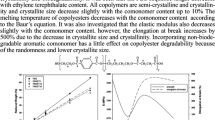Abstract
Amorphous biodegradable copolyesters have been synthesized using various alicyclic monomers, including 1,4-cyclohexanedimethanol (CHDM), 1,4-cyclohexanediol (CHDO), isosorbide (1,4:3,6-dianhidro-D-sorbitol) (IS), and 1,4-cyclohexane dicaboxylic acid (CHDA), to enhance the thermal properties of polyesters. We have studied the effect of alicyclic monomers on the thermal properties, especially, on the glass transition temperature (T g ) of the amorphous copolyesters. On incorporating alicyclic diol monomers into poly(ethylene succinate-co-terephthalate) (PEST), T g of amorphous copolyesters was greatly increased. As the rigidity of alicyclic monomers increases, the effect becomes more significant. By comparing copolyesters synthesized with the same molar ratio of alicyclic monomers in the feed, we found that the molar ratio of IS in the copolyester product was much smaller than those of CHDM and CHDO. Nonetheless, IS induced the largest T g enhancement in copolyesters even though a much smaller molar ratio of IS was incorporated in the product compared to CHDM and CHDO. To study the effects of alicyclic diacid monomers, copolyesters containing CHDA were synthesized. As in the case of alicyclic diols, CHDA was found to be very effective in enhancing the thermal properties. Among these copolyesters produced, PEI30ST synthesized with 30 mol% of succinic acid (SA) and 70 mol% of dimethyl terephthalate (DMT) as diacid and 30 mol% of IS as diol exhibited the highest T g of 74.2 °C. And poly(ethylene-co-CHDM succinate-co-terephthalate) (PEC30ST70) and poly(ethylene-co-IS succinate-co-terephthalate) (PEI30ST70) exhibited high optical transmittance and were confirmed to be biodegradable, exhibiting about 50% and 40% biodegradability, respectively, after 50 days in a biodegradability test under compost conditions. Hence, these novel transparent biodegradable polyesters could be highly useful in flexible packaging applications requiring transparency.

Similar content being viewed by others
References
S. Richard Turner, J. Polym. Sci., Part A: Polym. Chem., 42, 5847 (2004).
R. Quintana, A. M. de Ilarduya, A. Alla, and S. Muñoz-Guerra, J. Polym. Sci., Part A: Polym. Chem., 49, 2252 (2011).
Y. Tsai, C.-H. Fan, C.-Y. Hung, and F.-J. Tsai, J. Appl. Polym. Sci., 104, 279 (2007).
Y. Tsai, L. C. Jheng, and C. Y. Hung, Polym. Degrad. Stab., 95, 72 (2010).
H. R. Kricheldorf, G. Behnken, and M. Sell, J. Macromol. Sci., Pure Appl. Chem., 44, 679 (2007).
L. Tan, Y. Chen, W. Zhou, J. Wei, and S. Ye, J. Appl. Polym. Sci., 121, 2291 (2011).
O. Martin and L. Averous, Polymer, 42, 6209 (2001).
G. L. Siparsky, K. J. Voorhees, J. R. Dorgan, and K. Schilling, J. Environ. Polym. Degrad., 5, 125 (1997).
J. W. Park and S. S. Im, J. Polym. Sci., Part B: Polym. Phys., 40, 1931 (2002).
M. Harada, T. Ohya, K. Iida, H. Hayashi, K. Hirano, and H. Fukuda, J. Appl. Polym. Sci., 106, 1813 (2007).
M. Shibata, Y. Inoue, and M. Miyoshi, Polymer, 47, 3557 (2006).
J. Lu, Z. Qiu, and W. Yang, Polymer, 48, 4196 (2007).
N. Ljungberg and B. Wessln, Polymer, 44, 7679 (2003).
Z. Florjanczyk, A. Józwiak, A. Kundys, A. Plichta, M. Debowski, G. Rokicki, P. Parzuchowski, P. Lisowska, and A. Zychewicz, Polym. Degrad. Stab., 97, 1852 (2012).
Yangchun Liu, S. Richard Turner, J. Polym. Sci., Part A: Polym. Chem., 48, 2162 (2010).
K. Tomita and H. Ida, Polymer, 16, 185 (1975).
H. C. Ki and O. O. Park, Polymer, 42, 1849 (2001).
F. Fenouillot, A. Rousseau, G. Colomines, R. Saint-Loup, and J.-P. Pascault, Prog. Polym. Sci., 35, 578 (2010).
D. N. Bikiaris, G. Z. Papageorgiou, and D. S. Achilias, Polym. Degrad. Stab., 91, 31 (2006).
J. Xu and B.-H. Guo, Biotechnol. J., 5, 1149 (2010).
R. Pritchard, SPE Transactions, 4, 66 (1964).
L.-M. Deng, Y.-Z. Wang, K.-K. Yang, X.-L. Wang, Q. Zhou, and S.-D. Ding, Acta Mater., 52, 5871 (2004).
Author information
Authors and Affiliations
Corresponding author
Rights and permissions
About this article
Cite this article
Ahn, J.S., Kang, S.M., Kim, M.K. et al. Effect of alicyclic monomers on thermal properties of transparent biodegradable polyesters. Macromol. Res. 24, 609–616 (2016). https://doi.org/10.1007/s13233-016-4078-5
Received:
Revised:
Accepted:
Published:
Issue Date:
DOI: https://doi.org/10.1007/s13233-016-4078-5




